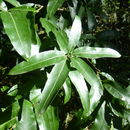More info for the terms:
shrub,
swamp,
tree,
vinesWillow oak grows primarily on floodplain sites that are commonly flooded
in the winter and spring, but only briefly during the growing season.
This species usually grows on ridges and high flats of first bottoms
which are the areas surrounding swamps and major rivers which flood
deeply and frequently, but drain rapidly because of relief. It also
grows along minor streams and on ridges, flats, and sloughs of second
bottoms which flood infrequently. It rarely occurs on uplands
[
6,
30,
34].
Willow oak is found in the forests on North Carolina's outer barrier
islands, but it is rarely encountered on South Carolina's outer
barriers [
15].
Willow oak grows best in moist alluvial soils that are deep,
uncompacted, and relatively undisturbed. The best soil is
medium-textured, silty or loamy, and has at least 2 percent organic
material and a pH between 4.5 and 5.5. The most common soils are in the
orders Inceptisols and Alfisols [
30]. The ideal depth of the water
table during the growing season is 2 to 6 feet (0.6-1.8 m). A water
table less than 1 foot (0.3m) or more than 10 feet (3 m) below the
ground surface is unsuitable for willow oak [
30,
34].
In addition to those species mentioned in Distribution and Occurrence,
overstory associates include red maple (Acer rubrum), cedar elm (Ulmus
crassifolia), eastern cottonwood (Populus deltoides), honeylocust
(Gleditsia triacanthos), persimmon (Diospyros virginiana), Nuttall oak
(Quercus nuttallii), chestnut oak (Q. prinus), and spruce pine (Pinus
glabra). Shrub and small tree associates include swamp privet
(Forestiera acuminata), roughleaf dogwood (Cornus drummandii), hawthorn
(Crataegus spp.), American hornbeam (Carpinus caroliniana), and red
mulberry (Morus rubra). Vines include Alabama supplejack(Berchemia
scandens), greenbrier (Smilax spp.), poison-ivy (Rhus radicans),
peppervine (Ampelopsis arborea), trumpet-creeper (Campsis radicans),
crossvine (Anisostichus capriolata), and grape (Vitis spp.) [
7,
10,
25,
30].

